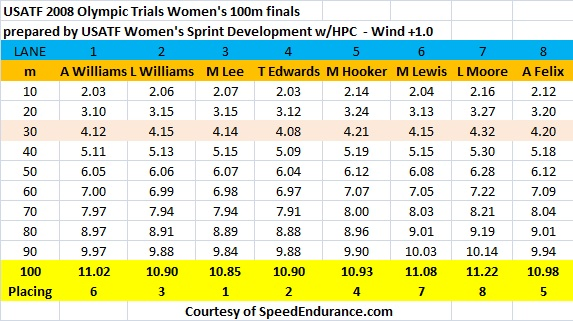Or, maybe a better way to say it: what is causing sprinters to slow down in the 100 meters pretty much immediately after they hit max velocity? A guy speeds up for 50-60 meters, hits a 0.85 ten-meter split and then usually hits a 0.86, a 0.87, a 0.88…
A few guys can hang on to a top split for two consecutive ten meter segments; I assume they’re still accelerating or decelerating, just at a level not discernible from simple split-taking.
What’s going on physiologically? There’s a great thread in the forums here about the lactic threshold (http://community.charliefrancis.com/showthread.php?558-How-far-do-we-get-for-our-7-5), but my admittedly basic understanding of the science here is that Sharmar’s response at the end is correct:
“Changes in muscle ATP and PCr during 14s of maximal effort sprinting causes a drop in ATP at a very high rate, the energy from PCr is used to rebuild ATP, preventing the ATP level from falling. At exhaustion both ATP and PCr is exhausted, it is then when both ATP and PCr is exhausted that the lactic system is recruited. During the 100m the alactic system is never exhausted since ATP and PCr is never fully depleted.”
However, Sharmar then says that the drop in performance is due to “neuromuscular factors” and not a shift in energy systems. But I’m not clear as to what this means.
Apparently, the positive effects of creatine are (a) significant and (b) come in during the last 40 meters of a 100 : http://sjss-sportsacademy.edu.rs/archive/details/full/muscle-metabolism-and-fatigue-during-sprint-exercise-effects-of-creatine-supplementation-11.html
(“100 m time on the track was improved after Cr but not after placebo intake (Placebo: 11.74 ± 0.35 vs. 11.76 ± 0.35, Cr: 11.68 ± 0.27 vs. 11.59 ± 0.31, P<0.02) with this difference being the result of a faster time during the last 40 m of the 100 m race.”).
Does this indicate that there’s more/better PCr stores for the creatine-supplemented athlete, such that the ATP can be rebuilt better?
Going purely on anecdote, my last two 10 meter splits are dramatically worse this year, when I’ve been off creatine, than they were last year, when I was on it.
Next question:What’s the most effective way of training speed endurance for the 100…and why?
Now, per Charlie himself, science should follow training… but I’d like to get an understanding of why people are getting their results out of their preferred methods of training SE.
So: what does running a 150 in training do for the last 30 meters of a 100 meters? I know I’ll be slowing down for everything after 60 meters (in fact, I’m an old fart who slows down after 50); what does running practice runs where I’m going 1.10+ for 100-110, 110-120, 120-130, etc., do for me trying to hold on to my top split and maybe go 0.99 from 60-70, 1.0 for 70-80, etc.?
Why not just run a bunch of really high quality 100s and more specifically work on that 50-100 meter segment? Is it to get my body used to running slightly submaximally and hang on to my form/technique as best as I can when my muscles are degraded?
I’d love to hear some opinions from the awesome minds of this site.
